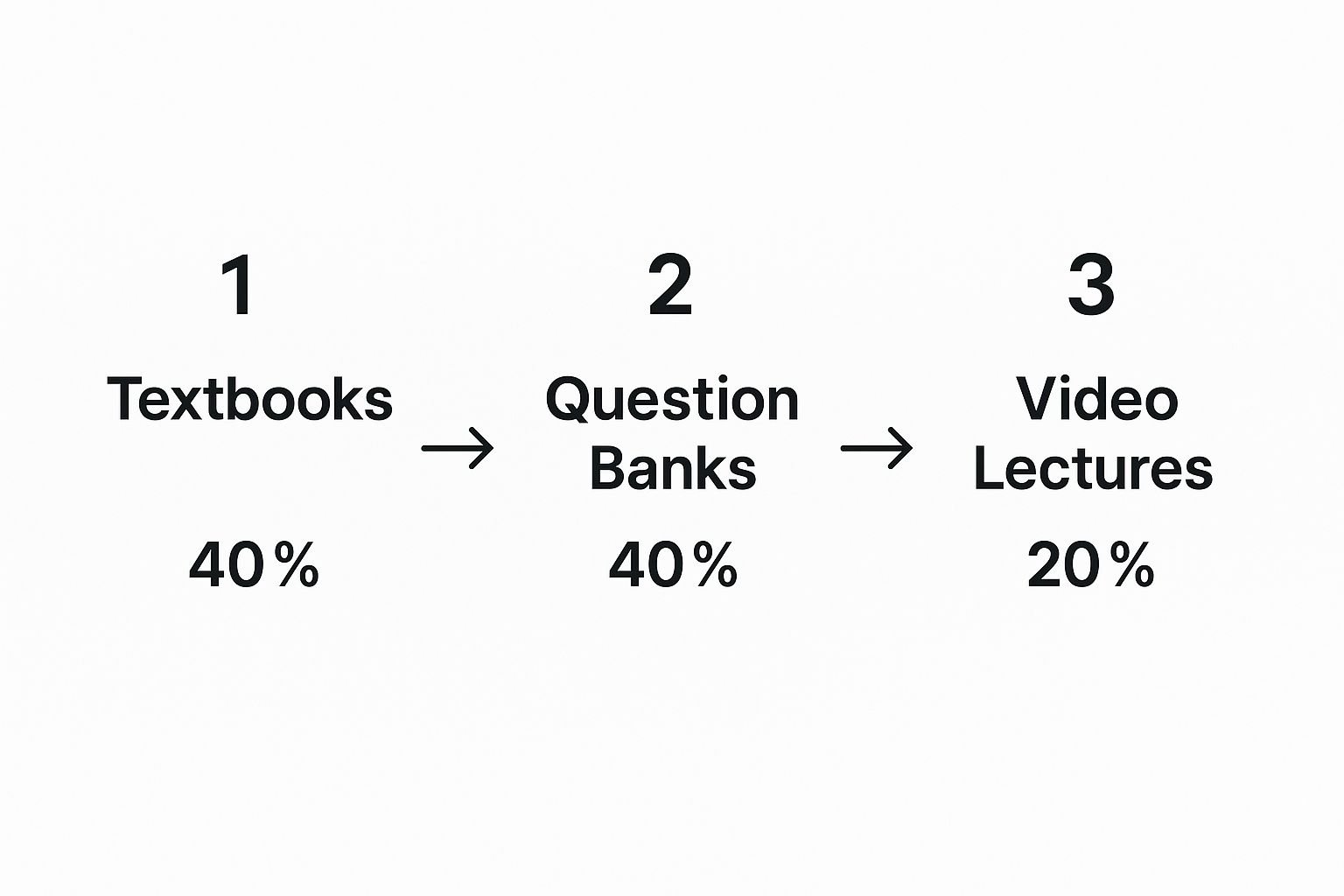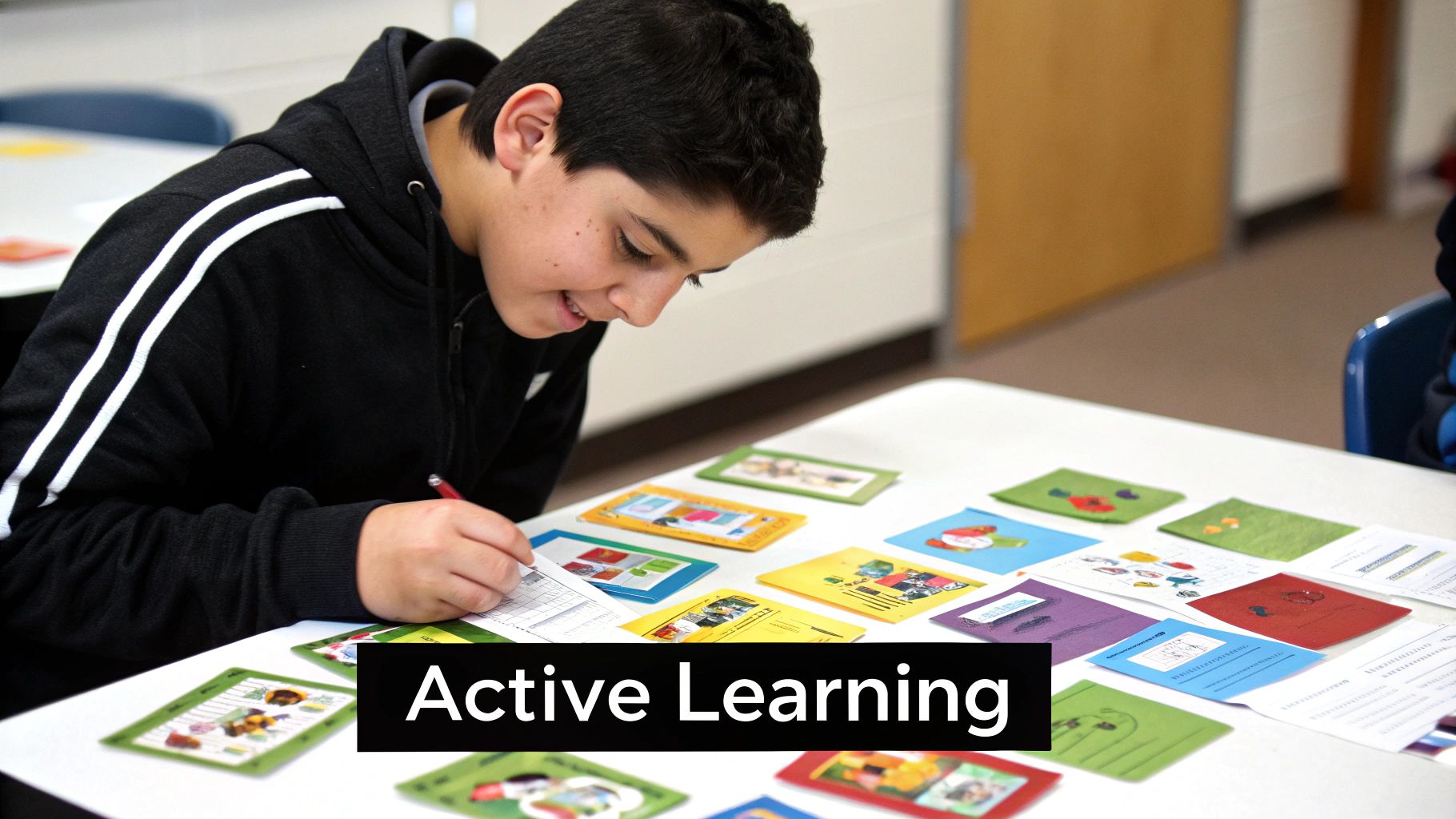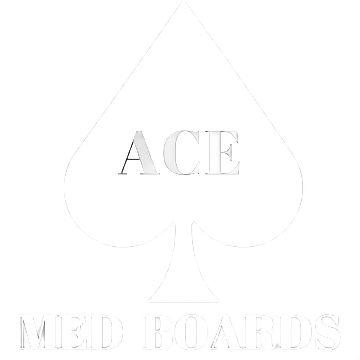A solid study plan is the single most important tool you have for crushing USMLE Step 1. It’s what breaks this monumental task down into a manageable, day-by-day process, turning that overwhelming anxiety into focused, productive action by telling you exactly what, when, and how to study.
Building Your Foundation for Step 1 Success
Staring down your USMLE Step 1 prep can feel like standing at the base of a mountain. It’s intimidating. Before you even think about taking that first step, you absolutely need a map. A well-designed study plan is that map—it provides direction, structure, and a clear path toward passing this beast of an exam.
The first phase isn't about frantically diving into random topics. It’s about being strategic.
This foundational stage starts with an honest self-assessment to figure out your baseline. Where do you really stand with subjects like biochemistry, pharmacology, or pathology? Pinpointing your genuine strengths and weaknesses right from the start lets you allocate your most precious resource—your time—way more effectively.
Set Meaningful and Realistic Goals
Obviously, your main goal is to pass. But effective goal-setting needs to be more specific than that. Your goals should be tangible, measurable, and actually achievable within your dedicated study period. A vague goal like "study cardiology" is useless. A much better goal is, "complete the UWorld cardiology block and review every single incorrect question within three days."
This kind of specific goal-setting helps you build momentum and gives you small, concrete wins to celebrate along the way. Your plan should also break things down further:
- Weekly Targets: Define the number of practice questions you'll tackle and the specific topics you'll cover each week.
- Practice Exam Goals: Schedule full-length practice exams (like the NBMEs) to get used to test-day conditions and track your progress.
- Content Mastery: Focus on deeply understanding the high-yield concepts, not just superficially memorizing every single detail in the book.
Understanding the Marathon Mentality
Let’s be real: prepping for Step 1 is a marathon, not a sprint. Burnout is a serious threat, and getting your head in the right space is just as critical as your academic readiness. A successful plan must acknowledge the need for rest and recovery.
Historically, the structure of a study plan has been a make-or-break factor in exam outcomes. Before the switch to pass/fail, students often ground through intense 6-to-12-week dedicated periods, logging over 300 hours of study. Surveys consistently showed that the students who did well were the ones using high-yield resources like UWorld, First Aid, and Pathoma, and integrating smart techniques like spaced repetition to lock in the material.
The goal isn't just to study hard; it's to study smart. Your initial plan sets the stage for a sustainable effort, preventing that all-too-common cycle of intense cramming followed by total exhaustion. A well-paced schedule is your best defense against burnout.
Ultimately, this foundational work is all about creating a strategy that is personalized to you. For more detailed templates and strategies you can adapt, check out our comprehensive guide on building a USMLE Step 1 study plan. By establishing a solid bedrock of knowledge and a clear roadmap now, you’re positioning yourself for success before you even open a single textbook.
Choosing Your High-Yield Study Resources

Alright, you've got your goals locked in. Now comes the fun part: picking your weapons. The market is absolutely flooded with USMLE resources, and every single one promises to be the magic bullet. This is where most medical students stumble into the classic trap of resource overload.
It’s so easy to do. You buy ten different books, subscribe to five video platforms, and suddenly you feel prepared. But that feeling is a dangerous illusion. In reality, you're setting yourself up for burnout by trying to drink from a firehose.
Real mastery comes from depth, not breadth. You need to know a few core resources inside and out, not just skim the surface of a dozen. This focused approach is what separates recognizing a concept from truly understanding it under pressure.
The Foundational Trio: Your Non-Negotiables
Every solid Step 1 plan I've ever seen is built on three core pillars. Think of these as your daily drivers—the tools you'll use to build, test, and reinforce everything you know.
- A Premier Question Bank (QBank): This is your single most important tool. A top-tier QBank like UWorld isn't just for testing yourself; it's a primary learning resource. The magic is in the explanations—that's where the deep learning happens.
- A Comprehensive Review Book: You need a central text that acts as your curriculum outline. First Aid for the USMLE Step 1 is the gold standard here. It organizes the insane volume of information and helps you see the connections between different organ systems.
- A High-Yield Pathology Resource: Pathology is a massive chunk of this exam. You absolutely need a dedicated resource like Pathoma to build a rock-solid conceptual framework for disease.
These three work together like a well-oiled machine. You'll introduce a topic in First Aid, get the deep story from Pathoma, and then immediately apply and test that knowledge with UWorld questions. It's a proven system.
To help you organize your toolkit, think of your resources in tiers.
Essential USMLE Step 1 Resource Tiers
Here’s a breakdown of core and supplemental study resources to help you build a focused and effective toolkit.
| Resource Tier | Purpose | Popular Examples |
|---|---|---|
| Tier 1: Foundational | Your daily non-negotiables. These form the core of your study plan. | UWorld, First Aid, Pathoma |
| Tier 2: Targeted Support | Used to fill specific knowledge gaps or suit your learning style. | Boards and Beyond, SketchyMedical, Anki |
| Tier 3: Supplemental | Optional resources for extra practice or alternative explanations. | Amboss, Kaplan QBank, Physeo |
Focus on mastering Tier 1 before even thinking about adding anything from Tier 3.
Adding Smart Supplemental Resources
Once your foundational trio is in place and you're using it consistently, you can thoughtfully add one or two supplemental resources. The key word here is thoughtfully. Don't add something just because you saw it on a forum.
These tools are meant to plug specific leaks in your knowledge, not replace your core trio.
For instance, if you're a visual learner struggling to cram pharmacology and microbiology, a platform like SketchyMedical can be a game-changer. Its wild, memorable visual mnemonics can save you hundreds of hours of rote memorization. Or, if complex physiology is your weak spot, the crystal-clear lectures from Boards and Beyond can make those tough concepts finally click.
The goal is to be surgical with your choices. Pick supplements that target your specific weaknesses, not just because they're popular. Committing to a small, high-quality set of tools will save you from decision fatigue and keep your study plan sharp and effective.
This disciplined approach is absolutely critical to building a study plan for USMLE Step 1 that gets results without driving you crazy. Fight the urge to pile on more resources. Instead, focus on mastering the few you've chosen.
Designing a Study Schedule That Actually Works
A generic, one-size-fits-all study schedule is a direct path to burnout and frustration. Your study plan for usmle step 1 has to be a custom-built machine, engineered around your personal timeline, learning pace, and daily commitments. It doesn’t matter if you have a focused 6-week dedicated period or are balancing studies with classes over several months—the principles of smart scheduling hold true.
The goal here is to create a structure that feels both disciplined and flexible. This isn't about cramming every waking hour with intense study. It's about finding a sustainable rhythm that maximizes high-yield learning without you losing your sanity in the process. A truly great schedule makes room for new content, active recall, and—critically—real downtime.
If you want to really dial things in, you can find great ways to improve efficiency in your workflow that apply perfectly to Step 1 prep.
The Power of Block Scheduling
One of the most effective strategies I’ve seen is block scheduling, where you dedicate specific chunks of time to organ systems or disciplines. Instead of jumping randomly between subjects, you create a focused, immersive learning environment for yourself.
A typical block might look something like this:
- Monday – Thursday: Go all-in on Cardiology. This means watching the relevant Pathoma videos, reading the Cardiology chapter in First Aid, and then hammering a 40-question block of UWorld questions on that system.
- Friday: This is your integration day. Use it for subjects like pharmacology and microbiology that cut across multiple systems. This approach keeps them from getting siloed and forgotten.
- Saturday: Time for a full-length practice test or a dedicated catch-up day for weaker topics you flagged during the week.
- Sunday: A much lighter day. Focus on reviewing your Anki cards and, most importantly, take a real break. Step away.
This method gives you a clear, week-by-week march through the material. It helps you ensure comprehensive coverage without feeling like you're just putting out fires.
Remember, the schedule is your tool, not your master. If you fall behind on a topic, adjust. The best plans are living documents that adapt to your real-time progress and needs.
This visual gives a great breakdown of how you should allocate your study time, emphasizing that foundational knowledge and active practice are equally important.

As you can see, your textbooks and question banks should each make up roughly 40% of your effort, with video lectures playing a key supplemental role.
Weaving In Consistent Review
Learning new information is completely useless if you can't pull it up on exam day. That’s why your schedule absolutely must build in time for systematic review. I’m not talking about passively re-reading your notes; this needs to be active, spaced repetition.
Your daily schedule should have protected time slots for these two non-negotiables:
- Morning Warm-up (30-60 mins): Knock out your daily Anki reviews first thing. This primes your brain and reinforces old concepts before you dive into anything new.
- End-of-Day Consolidation (60 mins): Go back and review the explanations for every single UWorld question you did that day—especially the ones you got right. This is where you find flawed reasoning and really make high-yield facts stick.
By making these review sessions a non-negotiable part of your daily routine, you start turning short-term memorization into durable, long-term knowledge. It ensures the cardiology you studied in week one is still fresh in your mind during week six, creating a powerful cumulative effect.
Mastering Active Recall and Practice Questions

Let's be brutally honest. You can't pass Step 1 by just reading First Aid or passively watching videos. Those are just the starting blocks.
The real gains, the ones that push you into that comfortable passing range, come from relentlessly testing yourself. This is where active recall and high-quality question banks become the absolute cornerstones of your study plan. You're shifting from a passive observer to an active problem-solver.
This isn't just about hammering through thousands of questions hoping something sticks. It’s a calculated strategy to hunt down your knowledge gaps, sharpen your clinical reasoning, and build the mental stamina for an eight-hour exam beast. To beat the test, you have to think like the test-maker—and that only comes with practice.
QBank Strategy: Tutor Mode vs. Timed Mode
Your question bank, especially a powerhouse like UWorld, needs to be used in two very different ways.
When you first start your dedicated study period, live in Tutor Mode. This is your learning phase. You answer a question and immediately dive into the detailed explanation. It’s an incredibly powerful way to connect a dry fact to a living, breathing clinical vignette.
But as your test date looms closer, you have to flip the switch. Start doing mixed question blocks in Timed Mode. This is where you build your test-taking armor. It forces you to manage the clock, make tough decisions under pressure, and get comfortable with the relentless pace of the real exam. This endurance is just as critical as knowing the material cold.
Here's a good way to structure this transition:
- First Half of Dedicated: Spend about 80% of your QBank time in Tutor Mode and 20% in Timed Mode.
- Second Half of Dedicated: Invert that ratio to 20% in Tutor Mode and 80% in Timed Mode.
This gradual shift builds your knowledge foundation first, then layers on the essential performance skills.
Reviewing Your Mistakes the Right Way
Getting a question wrong is a gift. Seriously. It’s a flashing neon sign pointing directly at a weakness. Your job isn't to just glance at the right answer and move on. You need to dig in and understand why you were wrong and why the correct answer was the best choice.
Create a system for reviewing every block. For each question you miss, ask yourself these three things:
- Was it a pure knowledge gap? Did you just not know the fact? If so, that's an easy fix—make a targeted flashcard and learn it.
- Was it a reasoning error? Did you fall for a clever distractor or misinterpret the vignette? Make a quick note of the faulty logic so you recognize the trap next time.
- Was it just a careless mistake? Did you rush, misread the question, or click the wrong bubble? Acknowledge it. It’s a simple reminder to slow down.
Don't just review your incorrects; analyze them. Soon, you'll spot patterns. "Wow, I consistently miss questions on renal physiology," or "I always misinterpret these specific lab values." This is gold. It’s invaluable data that tells you exactly how to adjust your study plan for usmle step 1.
This deep analysis transforms your QBank from a simple assessment tool into a personalized diagnostic machine.
To make this knowledge stick for good, integrating a tool like Anki for spaced repetition is a total game-changer. For a deeper dive into making your study sessions insanely effective, check out these techniques on how to master https://acemedboards.com/active-recall-for-medical-students/. This is how you turn passive review into durable, long-term memory that will be there for you on exam day.
How to Track Progress and Adapt Your Plan

Here’s a hard truth: a static study plan is a failed study plan. Think of your initial schedule as a hypothesis. Your performance data is the experiment that proves or disproves it. The real key to a successful prep period is treating your plan like a living, breathing document—one that evolves based on cold, hard data from your QBank and practice exams.
This adaptive approach is more critical than ever. Since the exam shifted to pass/fail in January 2022, the margin for error has gotten tighter. First-time pass rates for US MD students dropped from 95% in 2021 to 90% in 2023. The decline was even sharper for international medical graduates, falling from 82% to 72% in the same period.
These numbers tell a clear story: you have to be ruthlessly strategic in shoring up your weak spots. And for that, data is your best ally.
Using Data to Pinpoint Your Weaknesses
Your QBank’s performance analytics dashboard is your mission control center. Don't just glance at your overall percentage correct. That’s a vanity metric. You need to dig deeper into the numbers that give you actionable insights.
Most platforms will break down your performance by:
- Discipline: Are you consistently fumbling questions in biochemistry or pharmacology?
- Organ System: Is the renal system your Achilles' heel while you’re crushing cardiology?
- Question Type: Do you freeze up when a question asks for the "mechanism of action"?
This isn't just data; it's your personalized diagnostic report. A 55% score in endocrinology isn't a failure—it’s a bright, flashing arrow telling you exactly where to focus your energy next. And of course, regularly scheduled NBME self-assessments provide the crucial benchmarks that show you the bigger picture of your progress.
Your QBank data isn’t a judgment—it’s a roadmap. It tells you where the potholes are so you can pave them over before test day. Acknowledging a weak area is the first step toward turning it into a strength.
Recalibrating Your Schedule for Maximum Impact
Once you’ve identified a weak area, you have to act on it immediately. This is where you adapt your study plan in real-time. If your data shows a consistent struggle with pharmacology, your original schedule needs an update—today.
This recalibration might look like a few different things:
- Reallocating Your Time: Carve out an extra study block specifically for your weak subject. This might mean temporarily stealing some time from an area where you're already scoring well.
- Changing Your Approach: If reading First Aid isn't cutting it for micro, maybe it's time to switch gears. Perhaps you need to binge-watch Sketchy videos or hammer out a targeted block of Amboss questions on ethics. The tool should fit the problem.
- Shifting Your Focus: As you get closer to your exam, your data might show that your knowledge base is solid, but your timing is slow. That's a clear signal to pivot from content review to doing more timed question blocks. It's about training for the test itself.
This continuous cycle of testing, analyzing, and adapting ensures you’re always working on the highest-yield task for your specific needs. For more guidance on structuring your preparation, our complete overview of https://acemedboards.com/how-to-prepare-for-usmle-step-1/ offers additional strategies. This dynamic process is what transforms a good plan into a great one.
Why a First-Time Pass Still Matters
With Step 1 now pass/fail, it's easy to fall into the trap of thinking you can dial back the intensity. That’s a dangerous mistake. The reality is, securing a pass on your first attempt has become a critical gatekeeper for your entire medical career.
The three-digit score is gone, but that doesn't mean residency programs ignore the result. In fact, a Step 1 failure has morphed into a massive, unambiguous red flag on your application. It immediately makes program directors question your foundational knowledge and your ability to handle the pressures of residency. It’s a blemish that’s hard to ignore.
The New Landscape of Residency Applications
So what are programs looking at instead? Without a score to rank applicants, the focus has shifted. According to the latest data from the 2024 NRMP charting outcomes, directors are placing much more weight on your Step 2 CK score, clerkship grades, and glowing letters of recommendation.
A clean, first-time pass on Step 1 is the prerequisite that keeps you in the game for all of those.
Think about it. A failure triggers a cascade of problems you really don't want to deal with:
- Delayed Rotations: Your school might pull you from clinical duties to remediate. This throws your entire schedule off, potentially delaying graduation.
- Weaker Step 2 Prep: All the time you spend re-studying for Step 1 is time stolen from your Step 2 CK preparation—an exam that now carries enormous weight.
- Added Stress and Financial Hits: The cost of retaking the exam, both in dollars and emotional toll, just adds another layer of pressure to an already intense journey.
The goal isn't just to scrape by with a "pass." The goal is a decisive, confident pass on your first try. This keeps every door open and removes any self-inflicted obstacles from your path.
Viewing Step 1 as just another hurdle to clear is shortsighted. It’s the foundation you’ll build your clinical years and residency match upon. Passing it cleanly the first time is your first major move toward building a competitive application.
Common Questions About Your Step 1 Study Plan
When you start mapping out your study plan for USMLE Step 1, a few big questions almost always pop up. Let’s cut through the noise and tackle the most common ones so you can build your schedule with total confidence.
How Long Should My Dedicated Study Period Be?
For most students studying full-time, the sweet spot for a dedicated period is somewhere between 6 to 10 weeks.
This usually gives you enough runway to get through a top-tier QBank like UWorld, really dig into high-yield resources, and take a few NBME self-assessments to see where you stand.
Of course, this isn't a hard and fast rule. If you're juggling classes or other commitments, you'll need to stretch things out. A longer, lower-intensity schedule spread over several months can get you to the same finish line without the burnout.
How Many Practice Questions Should I Do?
Make it your mission to complete at least one full pass of the entire UWorld QBank. Right now, that’s over 3,700 questions.
But just getting through them isn't the real goal. The learning happens when you systematically break down every single explanation—yes, even for the questions you got right.
Many high-scorers also do a second pass, but they focus strategically on their incorrect and marked questions. It’s all about targeted review.
Remember, the quality of your review is far more important than the sheer number of questions you answer. One question you truly understand is worth ten you just clicked through.
What Does the Final Week Look Like?
That last week before your exam is all about consolidation and building confidence. It is not the time to cram new information. Trying to learn a complex biochemical pathway the day before the test is a recipe for anxiety.
Instead, your final week should be about light, high-yield review.
- Final Review: Do a quick pass over your marked QBank questions and any notes you made on your weakest topics. This is also a great time to skim the charts and diagrams in First Aid.
- Final Practice: Take the official Free 120 practice exam about 2-3 days before your test. This helps you get comfortable with the real exam's interface and question style.
- Final Rest: Take the entire day before your exam completely off. No exceptions. Do something relaxing that has absolutely nothing to do with medicine. Your brain needs to be fresh for the marathon ahead.
Feeling like you're trying to piece together a thousand-piece puzzle? The expert tutors at Ace Med Boards specialize in creating personalized study plans that turn that anxiety into a clear, actionable strategy. Book a free consultation today and build a plan that’s made just for you.
